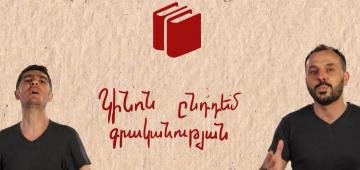 |
The potential of Armenian fantasyAlthough Armenian-language works of the fantasy genre have been written a lot in recent years, this genre, which is loved all over the world, still has great opportunities and potential for development in our country. What are the peculiarities of Armenian fantasy, thanks to which it can develop in our country? The “Parallel Readings” program features literary critics Hayk Hambardzumyan, Arkmenik Nikoghosyan, and prose writer Artavazd Yeghiazaryan. |
 |
Our bookshelf in 2025At the beginning of the year, many book lovers organize their bookshelves and plan what they will read during the new year. As part of the “Parallel Readings” program, literary critics Hayk Hambardzumyan and Arkmenik Nikoghosyan present the upcoming anniversaries of Armenian writers of the year, recommending which of their works to start reading and why. |
 |
Christmas in the Treasury of Gregory of NarekThe theme of Christmas finds its unique artistic realization in the treasures and tales of Saint Gregory of Narek. The traditional images of Armenian spiritual poetry are supplemented with new and diverse lines and shades of expression in the works of Gregory of Narek. Literary critics Hayk Hambardzumyan and Arkmenik Nikoghosyan discuss the works on the theme of Christmas in the work of the medieval genius. |
 |
Literary Year in "Parallel Readings"During 2024, every week, the "Parallel Readings" program hosted literary and reading discussions about various literary works, issues of literary theory and history, and touched upon anniversaries and important events. The passing literary year and its reflections are discussed by literary critics Hayk Hambardzumyan and Arkmenik Nikoghosyan. |
 |
About one story: O. Henry, "The Gift of the Magi"Christmas and the mysteries of this bright holiday have found their artistic expression in works of Armenian and world literature, but there is one story where the spiritual significance of the holiday is expressed in a unique way. O. Henry's famous story "The Gift of the Magi" is discussed by literary critics Hayk Hambardzumyan and Arkmenik Nikoghosyan. |
 |
Cinema vs. Literature: Part 2Do unsuccessful film adaptations of literature harm literature, how and by what principles is film adaptation evaluated, and what does it give to literature? These questions are discussed in parallel by literary critics Hayk Hambardzumyan, Arkmenik Nikoghosyan, and film critic Karen Avetisyan. |
 |
Cinema for the sake of literature: part 1
Film adaptations are one of the most diverse, creative connections and remarkable manifestations of relationships between fiction and cinema. Are film adaptations of famous literary works made for the sake of literature, do they contribute to a new reading and recognition of literature, do they stimulate reading, or, nevertheless, does cinema solve its own problems? Literary critics Hayk Hambardzumyan, Arkmenik Nikoghosyan, and film critic Karen Avetisyan discuss the topic in parallel.
|
 |
Daniel Varuzhan- the song of the BreadDaniel Varuzhan's last, miraculously saved and posthumously published, remarkable series "The Song of Bread" presents the process of bread creation, from sowing to baking. This poetic series has powerful ideological and psychological charges and important goals. In the "Parallel Readings" program, D. Varuzhan's "The Song of Bread" series is discussed by literary critics Hayk Hambardzumyan and Arkmenik Nikoghosyan. |
 |
Within a story, Stepan Zoryan, "Fence"
Perhaps the most famous story of the famous prose writer, “The Fence”, at first glance, tells about a simple everyday quarrel that disrupts people's relationships, affects their inner world and psychology. However, this simple story provides an opportunity for deeper analysis. Stepan Zoryan's story “The Fence” is discussed by literary critics Hayk Hambardzumyan and Arkmenik Nikoghosyan on the “Parallel Readings” program.
|
 |
Family sagas in Armenian literature
In world literature, the family saga, as a form within the novel's genre, is quite well-known and widespread, and such masterpieces as Thomas Mann's "The Buttenbrooks" or Emily Bronte's "The Tale of the Wind in the Wind" are just such realizations. But it is also a fact that the family saga is not characteristic of the literature of all peoples. What is the uniqueness of this genre, do we have family sagas in Armenian literature? Literary critics Hayk Hambardzumyan and Arkmenik Nikoghosyan discuss the program "Parallel Readings".
|
 |
Aznavour, a memoirist and a novelist
Charles Aznavour has written remarkable memoirs, autobiographies, even short stories and a novel. What is unique about his published prose? Literary critics Hayk Hambardzumyan and Arkmenik Nikoghosyan discuss the program "Parallel Readings"
|
 |
The Poet Aznavour
We cannot imagine the words of Charles Aznavour's famous songs without the accompaniment of a melody, but the words of hundreds of Aznavour's songs can also be read as poetry. Can we talk about the poet Aznavour and what are the characteristics of these poems? Literary critics Hayk Hambardzumyan and Arkmenik Nikoghosyan discuss these issues in the program "Parallel Readings".
|
